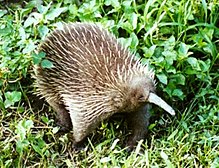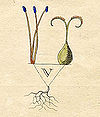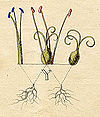User:Petter Bøckman/Sandbox
| Echidna Temporal range:
| |
|---|---|

| |
| Western long-beaked echidna | |
| Scientific classification | |
| Kingdom: | |
| Phylum: | |
| Class: | |
| Order: | |
| Family: | Tachyglossidae Gill, 1872
|
| Species | |
|
Genus Tachyglossus | |
Pterodactyl is a vernacular name for:
- The members of Pterodactylus, the first group of Pterosaurs discovered, also occasionally applied to the Pterodactylidae family of similar animals.
- Sometimes erroneously used for pterosaurs in general.
blablabla.[1]
lhgyuf [2]
Cladex
[edit]Taxobox
[edit]| Common ancestor |
| ||||||||||||
Violence
[edit]A common misconception often quoted by media, politicians, activists is that violence is on the rise and has historically been much lower.[3] Similarly, the trend in post-colonial anthropology has been to regard historically indigenous and tribal societies as more peaceful than contemporary Western society.[4][5] However, archaeological evidence shows that previous societies had very high level of violence.[6] Likewise, modern tribal societies typically too have extremely high rates of violence, with more than half of deaths being violence related in some cases.[7][8] Ancient and medieval empires had lower rates of violence, and the violence decreased further as empires became more organized.[9] Modern societies saw still lower rates of violence from the medieval period onwards, with significant decreases after World War II.[10][11] This trend is general across all categories of violence, from large-scale warfare to murder and animal cruelty, and the trend is discernible on both millennium, century and decade scale, making modern societies are the most peaceful the world has even seen.[12]
Plants
[edit]
His orders and classes of plants, according to his Systema Sexuale, were never intended to represent natural groups (as opposed to his ordines naturales in his Philosophia Botanica) but only for use in identification. They were used in that sense well into the nineteenth century. The system were based on the number and relative size of the male reproductive organs, the stamens and their placement in relation to the female pistillum. The classes were further subdivided into orders based on the number of the female pistil. Below the classis-level, plants were further divided into orders by counting the numbers of pistils, which reduced the number of genii in each order down to a manageable level.
This system removed the need for intimate knowledge of a large number of plants, allowing anyone able to count and armed with basic flower anatomy, the ability to classify plants. While the system often lumped unrelated genera with each other, it allowed for an easy and safe classification, particularly important with medical plants, and proved immensely useful and popular.[13]
The Linnaean classes for plants, in the Sexual System, were:
| REGIUM PLANTEA | |||||
|---|---|---|---|---|---|
| № | Name | Diagnosis | Picture | Selected genera[14] | |
| 1 | Monandria | Flower-bearing plants with bisexual flowers, with only one stamen | 
|
Canna, the canna lillies | |
| 2 | Diandria | Flower-bearing plants with bisexual flowers, with two separate stamens. Stamens of equal length. | 
|
Veronica | |
| 3 | Triandra | Flower bearing plants with bisexual flowers, with tree separate stamens. Stamens of equal length. | 
|
Poa, the typical meadow-grasses | |
| 4 | Tetrandria | Flower bearing plants with bisexual flowers, with four separate stamens. Stamens of equal length. | 
|
Protea | |
| 5 | Pentandria | Flower bearing plants with bisexual flowers, with five separate stamens. Stamens of equal length. | 
|
Campanula, the bellflowers | |
| 6 | Hexandria | Flower bearing plants with bisexual flowers, with six separate stamens. Stamens of equal length. | 
|
Lilium, the true lillies | |
| 7 | Heptandria | Flower bearing plants with bisexual flowers, with seven separate stamens. Stamens of equal length. | 
|
Æsculus, the horse chestnut trees | |
| 8 | Octabdria | Flower bearing plants with bisexual flowers, with eight separate stamens. Stamens of equal length. | 
|
Vaccinium, the blueberries and relatives | |
| 9 | Enneandria | Flower bearing plants with bisexual flowers, with nine separate stamens. Stamens of equal length. | 
|
Laurus | |
| 10 | Decandria | Flower bearing plants with bisexual flowers, with ten separate stamens. Stamens of equal length. | 
|
Rhododendron | |
| 11 | Dodecandria | Flower bearing plants with bisexual flowers, with 12-19 separate stamens. Stamens of equal length. | 
|
Euphorbia | |
| 12 | Icosandria | Flower bearing plants with bisexual flowers, with 20 (sometimes more) separate stamens growing from the calyx. Stamens of equal length. | 
|
Opuntia, the cactus figs | |
| 13 | Polyandra | Flower bearing plants with flowers where 20 or more stamens grow from the receptacle rather than the calyx. Stamens of equal length. | 
|
Ranuculus, the buttercups | |
| 14 | Didynamia | Flower bearing plants with bisexual flowers, with two long and two short separate stamens | 
|
Lamium, the deadnettles | |
| 15 | Tetradynamia | Flower bearing plants with bisexual flowers, with four long and two short separate stamens. | 
|
Brassica, the cruciferous vegetables | |
| 16 | Monadelphia | Flower bearing plants with bisexual flowers, where stamens branch from a single stalk. | 
|
Malva, the mallows | |
| 17 | Diadelphia | Flower bearing plants with bisexual flowers, where stamens branch from two separate stalks | 
|
Fava, the beans | |
| 18 | Polyadelphia | Flower bearing plants with bisexual flowers, with stamens branching from multiple (more than two) stalks | 
|
Hypericum, the St. John's worts | |
| 19 | Syngenesia | Flower bearing plants with bisexual flowers, where stamens are joined all the way up to the pollen-bearing anther. | 
|
Aster | |
| 20 | Gynandria | Flower bearing plants with bisexual flowers, where the stamens are joined to the pistil | 
|
Cypripedium, the lady's slippers | |
| 21 | Monœcia | Flower bearing plants with with separate female and male flowers, both found on the same plant. | 
|
Betula, the birches Carex Pinus, the pines | |
| 22 | Diœcia | Flower bearing plants with with separate female and male flowers, each are confined to separate male and female plants. | 
|
Salix, the willows | |
| 23 | Polygamia | Flower bearing plants with a mix of unisexual and bisexual flowers. | 
|
Acer, the maples. | |
| 24 | Cryptogamia | Plants which according to Linnaeus "hide their wedding", i.e. no obvious flowering structure. This includes spore-bearing plants, mosses, algae, lichen and fungi. | 
|
Equisetum, the horsetails Petris, the brakes | |
- Classis 1. Monandria, plants with bisexual flowers with one stamen
- Classis 2. Diandria, plants with bisexual flowers with two separate stamens
- Classis 3. Triandria, plants with bisexual flowers with tree separate stamens
- Classis 4. Tetrandria, plants with bisexual flowers with four separate stamens
- Classis 5. Pentandria, plants with bisexual flowers with five separate stamens
- Classis 6. Hexandria, plants with bisexual flowers with six separate stamens
- Classis 7. Heptandria, plants with bisexual flowers with seven separate stamens.
- Classis 8. Octandria, plants with bisexual flowers with eight separate stamens
- Classis 9. Enneandria, plants with bisexual flowers with nine separate stamens
- Classis 10. Decandria, plants with bisexual flowers with ten separate stamens
- Classis 11. Dodecandria, plants with bisexual flowers with 12-19 separate stamens
- Classis 12. Icosandria, plants with bisexual flowers with 20 (sometimes more) separate stamens growing from the calyx
- Classis 13. Polyandra, plants with flowers where 20 or more stamens grow from the receptacle rather than the calyx
- Classis 14. Didynamia, plants with bisexual flowers with two long and two short separate stamens.
- Classis 15. Tetradynamia, plants with bisexual flowers with two four long and two short separate stamens.
- Classis 16. Monadelphia, plants with bisexual flowers where stamens branching from a single stalk
- Classis 17. Diadelphia, plants with bisexual flowers where stamens branching from two separate stalks
- Classis 18. Polyadelphia, plants with bisexual flowers with stamens branching from multiple (more than two) stalks
- Classis 19. Syngenesia, plants with bisexual flowers where stamens are joined all the way up to the pollen-bearing anther.
- Classis 20. Gynandria, plants with bisexual flowers where the stamens are joined to the pistil
- Classis 21. Monœcia composed of plants with separate female and male flowers found on the same plant
- Classis 22. Diœcia composed of plants where female and male flowers are confined to separate plants.
- Classis 23. Polygamia Composed plants with a mix of unisexual and bisexual flowers.
- Classis 24. Cryptogamia composed of plants which according to Linnaeus "hide their wedding", spore-bearing plants, mosses, algae, lichen and fungi.
References
[edit]- ^ Tudge, Colin (2000). The Variety of Life. Oxford University Press. ISBN 0198604262.
Mammals are a clade, and therefore the cladists are happy to acknowledge the traditional taxon Mammalia; and birds, too, are a clade, universally ascribed to the formal taxon Aves. Mammalia and Aves are, in fact, subclades within the grand clade of the Amniota. But the traditional class Reptilia is not a clade. It is just a section of the clade Amniota: the section that is left after the Mammalia and Aves have been hived off. It cannot be defined by synapomorphies, as is the proper way. It is instead defined by a combination of the features it has and the features it lacks: reptiles are the amniotes that lack fur or feathers. At best, the cladists suggest, we could say that the traditional Reptilia are 'non-avian, non-mammalian amniotes'
- ^ ISBN 978-0-87169-240-5
- ^ Pinker, Steven. "1 A Foreign Country -Human prehistory". The better angels of our nature : why violence has declined. New York: Viking. p. 2. ISBN 978-0-670-02295-3.
In a century that began with 9/11, Iraq, and Darfur, the claim that we are living in an unusually peaceful time may strike you as somewhere between hallucinatory and obscene. I know from conversations and survey data that most people refuse to believe it.
- ^ Chagnon, N.A. (1996).Bock, G.R & Goode, J.A. (eds.) (ed.). Genetics of criminal and antisocial behaviour. Chichester: Wiley. pp. 202–231. ISBN 0471957194.
{{cite book}}:|editor=has generic name (help)CS1 maint: multiple names: editors list (link) - ^ Keeley, Lawrence H. (1996): War Before Civilization New York: Oxford University Press. ISBN: 0195119126
- ^ Martin, Debra L., and David W. Frayer, eds. Troubled Times: Violence and Warfare in the Past. Amsterdam: Gordon and Breach, 1997
- ^ "The fraud of primitive authenticity". Asian Times. 4th of July, 2006. Retrieved 16 July 2013.
{{cite news}}: Check date values in:|date=(help) - ^ Wade, Nicholas (2006). Before the Dawn: Recovering the Lost History of Our Ancestors (4th print. ed.). New York: Penguin Press. ISBN 1-59420-079-3.
- ^ Diamond, Jared (1997). Guns, germs and steel : a short history of everybody for the last 13,000 years (5th print. ed.). London: Vintage. pp. 155–292. ISBN 0-09-930278-0.
- ^ Eisner, M. (2003). "Long-Term Historical Trends in Violent Crime" (PDF). Crime and Justice. 30: 83–142. Retrieved 22 July 2013.
- ^ Lindström, Dag (2009). Body-Gendrot, S. & Spierenburg, P. (ed.). Violence in Europe. pp. 43–64.
{{cite book}}: CS1 maint: multiple names: editors list (link) - ^ Pinker, Steven. The better angels of our nature : why violence has declined. New York: Viking. ISBN 978-0-670-02295-3.
- ^ Stearn, W.T. (1957). Carl Linnaeus - Species Plantarum - A facsimile of the first edition 1753, Vol. 1. (with introduction). The Ray Society. pp. 1–176.
- ^ al.], Dennis W. Woodland ; with contributions by Todd Barkman ... [et (2009). Contemporary plant systematics (PDF) (4th ed. ed.). Berrien Springs, Mich.: Andrews University Press. p. 364. ISBN 1883925649. Retrieved 3 November 2014.
{{cite book}}:|edition=has extra text (help)CS1 maint: multiple names: authors list (link)
